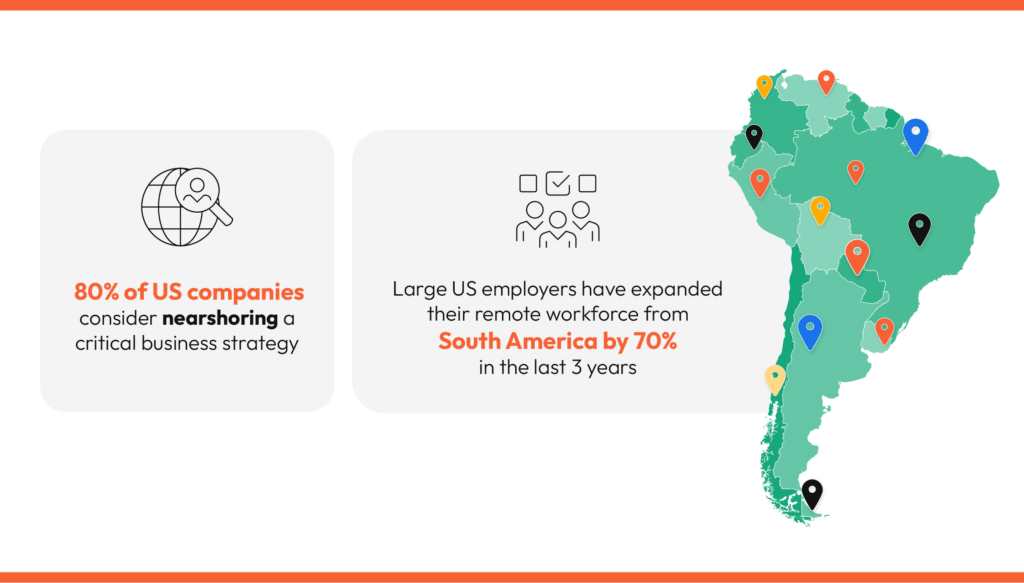There is a need for more developers in the US. While reasons as to why this is occurring may abound, the most important one is the massive and swift digital transformation companies across all industries are facing. This has caused a growth in the demand for software engineers by 17% across all sectors.
Currently, the United States produces around 100,000 graduates with computer science degrees each year. However, in 2022, there were over 260,000 new jobs in demand. With that limited number of graduates and the steady increase in demand, the gap is destined to widen even further.
The International Data Corporation has predicted a global shortfall of several million developers by 2025, which could result in approximately $8.5 trillion in unrealized annual revenues by 2030. Not only that, but according to the US Bureau of Labor Statistics, software developers, QA analysts, and testers jobs are projected to grow 25% (2022–2032), much faster than the average for all occupations. About 153,900 openings are expected each year, on average, over the decade.
With such a significant gap between the demand and the supply of quality developers in the US and the world, American companies are forced to look beyond their borders for skilled engineers. But where can they find them? The answer could be somewhere closer to home than expected.

Sources: ComputerWeekly, Korn Ferry, Bureau of Labor Statistics
Latin America, More Than Just Beautiful Beaches
One alternative to meet this demand is by looking south. Latin America (LATAM) has many advantages that position it as one of the most attractive regions to find the developers American companies are missing.
The remote work boom presents an even more significant opportunity for LATAM to position itself as the new emerging exporter of tech talent in the world. This would support the region’s development through economic growth, access to knowledge, and ongoing cross-border collaboration. Talented individuals no longer need to leave their communities to have access to better job opportunities, a phenomenon we call “e-migration.”
At BairesDev, we have 25 million hours of software development experience from LATAM engineers servicing American-based companies. Since 2009, our clients have reported more creative, resourceful, and relationship-focused interactions than transactional ones.
Tecla recently reported that 80% of US companies consider nearshoring a critical business strategy. Over the past three years, large employers in North America have expanded their remote workforce from South America by 70%. In 2021, LATAM professionals appeared as the most requested by companies worldwide, growing 156% between July and December. This trend continued in 2022, positioning LATAM as the hottest region to hire from.
While other regions of the world remain top of mind when speaking about offshoring software outsourcing needs, LATAM and nearshore delivery is a rising and competitive location model that provides unique value for outsourcing services.
What Is Causing the Latin American Boom?
In the last two decades, investment in education has increased in the region. Between 2000 and 2017, it went from 3.9% to 4.5% of the GDP and increased from 14.9% to 17% of the public expenditure, which is within the UN’s Sustainable Development Goals of 4–6% of the GDP and 15–20% of the public spending. According to a UNESCO report, since 2017, Costa Rica has led investment in education with 7.4% of the GDP, followed by Brazil with 6.2%, Argentina with 5.9%, Mexico with 4.9%, and Colombia with 4.5%.
Governments throughout LATAM have created programs to encourage STEM (science, technology, engineering & mathematics) education. Argentina and Brazil developed national Computer Science curriculum guidelines from 2015 to 2021 for primary and secondary education after decades of educational technology programs that equipped schools and integrated the use of digital software in schools.
One example of successful policies is Chile’s National Plan for Digital Languages, introduced by the Ministry of Education to encourage more students to take up computer science and engineering careers. This plan starts before college, with institutions teaching lessons in computer science topics and training their teachers in the field.
Another report mentions that, since 1988, Costa Rica and the Omar Dengo Foundation created an uninterrupted alliance that has gradually gained coverage and updated its curriculum to include Computer Science concepts. From 2007 onward, Uruguay has worked on infrastructure, connectivity, and digital teaching resources. In 2017, the Computational Thinking program started.
Currently, organizations such as Google, Siemens, and IAB, among others, are actively investing in technology education in the region.
As previously stated in this article, US universities graduate less than 50,000 software engineers yearly. Mexico and Brazil combined, on the other hand, turn out 605,000 software engineers annually, so there is a clear emphasis put on tech education in those two lands. By the way, this impressive number is without considering the graduates in other important countries in the region.
Ready to tap into LATAM’s top 1% tech talent? Schedule a call with us to learn more.
Why Are Latin American Developers a Good Fit for American Companies?
There are many reasons why LATAM developers are the best fit for any American company looking to outsource their development needs. The first is time zone and cultural alignment. LATAM offers business and technology talent, enhanced infrastructure, and the benefit of substantial time zone and cultural overlap with North America, making it ideal for same-time-zone operations.
LATAM’s tech scene is booming, defying economic and political issues in the region. Regarding the LATAM IT market in 2022, Brazil had a market worth of $45B, followed by Mexico with $28B, and Peru with $6.5B. LATAM’s SaaS market’s total venture capital investments peaked at over $1.8B in 2020, twice as high as in 2017, reaching 1,270 venture capital deals. This shows the potential for the region to become a leading force in the technology industry.
Also, there are virtually no language barriers. Aside from access to tech education, LATAM countries consistently rank moderate to high on the English Proficiency Index.
There has also been a remote work explosion after 2020. According to Forbes, 98% of workers want to work remotely, at least partially. From January to December 2022, of all contracts, 89% were for remote workers.
All these factors power the growth and development of a region with a booming tech scene. Many famous tech giants and startups are outsourcing IT projects to LATAM, further contributing to its influence as the place for IT and software engineering. Besides, some tech bigwigs, including Amazon, Airbnb, Dell, GoDaddy, Google, Netflix, and HP, have already set up shop in Brazil. Because of that, many LATAM developers have vast experience working with the spectrum of tech projects and companies, from startups to Fortune 500.
The region has also experienced a boom in tech companies, becoming a tech hub. In 2022, there were nearly 50 unicorns—new companies valued at over $1 billion—with 18 reaching such a status in 2021 alone.
Conclusion
The developers and software engineers from LATAM are good, very good. They have the proper education, seniority, and experience working with big international firms. They are proficient in English and live and work in the same time zone as you; we could go on and on with this.
Yes, that might be a biased statement, but the results are there. Believe us; we know how great these guys are.








